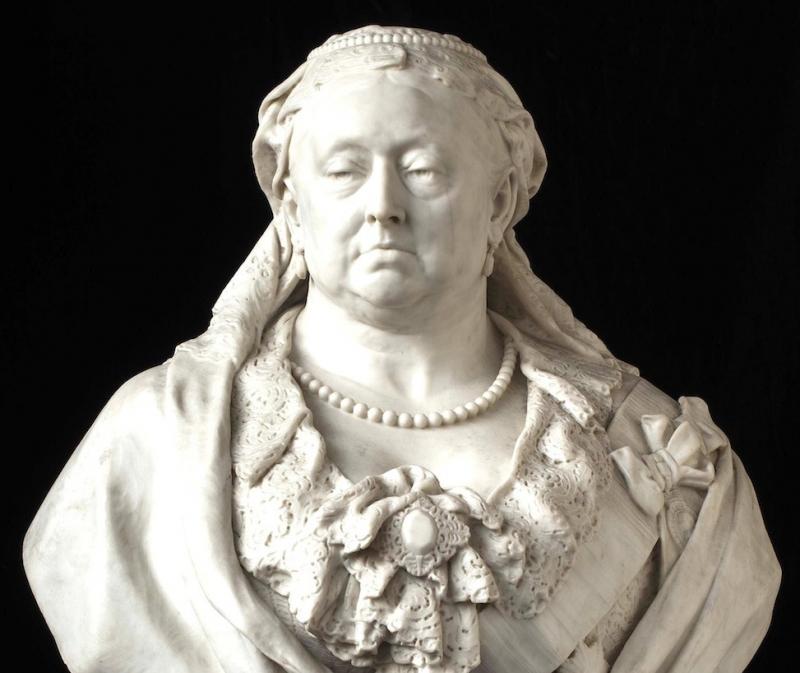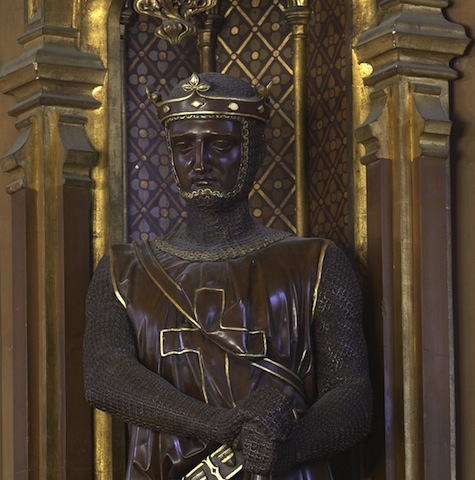Sculpture Victorious, Tate Britain | reviews, news & interviews
Sculpture Victorious, Tate Britain
Sculpture Victorious, Tate Britain
Technical innovation often coupled with meaningless extravagance

Recent attitudes to Victorian Britain have changed radically. The popular view used to be of a period filled with a kind of smug imperial confidence, underwritten by the increasing wealth of the industrial age. This ingrained assumption was perhaps epitomised by Lytton Strachey’s 1918 Eminent Victorians, which saw the eminences as bungling hypocrites.
This simplistic summary was leavened by acknowledging geniuses from Darwin to William Morris. However, the material culture, has been distinguished mostly by what modern sensibilities would now define as kitsch. It was also a time that collecting art of past and present was pursued with enthusiastic avidity, and almost all our public museums and galleries were founded. As wealth increased, it was flaunted, and often with philanthropic and didactic zeal.
Contemporary art flourished with unusual patronage, but it has become customary to denigrate its quality. Only recently in living memory has Victorian art come back into fashion, commercially and critically, and, of course, museums and galleries, followed by the market, have led the way.
The emphasis is as much on technical achievement as aesthetic aspiration
So is Sculpture Victorious, one in the recent parade of special showings from the Pre-Raphaelites on, a revisionist exhibition? The catalogue is as weighty as the subject. The premise is that not only was there significant patronage in the Victorian period, but that both private and public sculpture – here taken to include jewellery, coinage, medals, medallions and trophies – was a primary beneficiary. The collection of sumptuous, extravagant, technically innovatory sculptures on view in a series of dramatic galleries, walls painted pale olive greens, duck egg blue and above all royal red the better to show off their contents, is truly breath-taking – but not always, indeed hardly, in a good way. To eyes honed by modernism, and the 20th century on, from Brancusi to Picasso, Henry Moore to David Smith to the reductions of minimalism, the work on view here is on a spectrum from the magnificent to the utterly ridiculous.
But taken as a piece of utterly fascinating social history as well as aesthetic, the show is unmissable. It is subtitled Art in an Age of Invention, 1837-1901, and the emphasis is as much on technical achievement as aesthetic aspiration.
Several seminal influences were the Great Exhibition of 1851, with its showcasing of invention and art worldwide; the influence of the short-lived Prince Albert, with his fervent belief in the arts, indeed his espousal of photography as a way of bringing art to the masses; and the need to ornament and decorate the new Houses of Parliament.
The opening salvo sets the scene: a room full not only of Victoriana but of Victoria herself. There is in fact a touching marble of the young Queen by Sir Francis Chantrey, himself such a successful artist that the Chantrey Bequest still purchases sculpture and painting for Tate, and in fact until the 1920s was the most important source for purchases, albeit of a relatively conservative nature. Then there is the elderly Queen, caught with thoughtful empathy in an impressive bronze by Edward Onslow Ford, whom Victoria thought really understood her. The piece itself was a study for a colossal monument for Manchester. The Queen liked the depiction so much she had it reproduced in marble (and small scale in bronze for gifts), and it was the last piece of royal art that she sanctioned before her death.
Sheer bravura technique is evident, too, in Alfred Gilbert’s marble bust with its ruffles, lace, necklace, earrings and drapery, all uncannily rendered in marble. Victoria’s expression is a combination of dignified inscrutability and a curious and almost appealing melancholy.
Royal statues were supplied for almost unending commemorations and anniversaries; unveiling ceremonies for impressive installations were held throughout British cities, and the empire too. An interactive video takes us on a tour of some of the surviving sculptures of the Queen, from India to Canada, Australia to South Africa.
 One of James Westmacott’s more than life-sized sculptures – unnervingly impassive, even robotic – of the barons of Magna Carta has left the House of Lords for the first time to visit Tate: Saher de Quincy, Earl of Winchester, 1848-1853 (pictured right) is zinc electroplated with copper and gilded. He is totally armoured in chainmail and wields an awesome axe. Westmacott produced 18 barons who supported Magna Carta, and normally all reside 24 feet above the ground in niches above the chamber of the House of Lords.
One of James Westmacott’s more than life-sized sculptures – unnervingly impassive, even robotic – of the barons of Magna Carta has left the House of Lords for the first time to visit Tate: Saher de Quincy, Earl of Winchester, 1848-1853 (pictured right) is zinc electroplated with copper and gilded. He is totally armoured in chainmail and wields an awesome axe. Westmacott produced 18 barons who supported Magna Carta, and normally all reside 24 feet above the ground in niches above the chamber of the House of Lords.
There are extraordinary flamboyances: one such, still in use, is the jewel-encrusted pastoral staff (1890) for the Bishop of St Asaph, designed by J D Sedding: a gleaming liturgical aid made of – take a deep breath – silver, silver gilt, copper alloy, enamel, crystals, pearls, and semi-precious stones, including garnets, agate, amethyst, topaz, opals and moonstones. And it features sculptures in miniature, too: a shepherd’s crook; Peter receiving the keys of heaven from Christ, and various other saints and bishops. It is a thing of ornate wonder.
In an adjacent glass case, there is an outburst of playful chivalry exemplified in the astounding technical tour de force of the silver Eglinton Trophy, invented for the faux medieval tournament, an endeavour that was briefly and expensively fashionable.
There is impressive if ponderous playfulness, too. Thomas Longmore and John Henk, modellers for Minton, who produced a huge (as befits the subject) and colourful elephant in lead and tin glazed earthenware; perched nearby on a miniature hill is Paul Comolera’s Peacock, also in majolica, and produced by Minton.
History, mythical or no, and symbolism, overt and covert, is a theme throughout. One of the more improbable is A Royal Game, 1906-1911, by William Reynolds-Stephens, an enormous piece in electrotyped bronze, wood, stone, abalone and glass, depicting a crouching Philip II of Spain playing chess with a beruffed, berobed and very upright Elizabeth I. One hardly knows whether to gasp, laugh or cry.
 There are thoughtful and admiring tributes to the classical ideal, veering from works of art in their own right to pastiche. Among these striking figures are Hamo Thornycroft’s bronze Teucer, 1881 (pictured left) a mythological archer, the gracefully assured figure a homage to a Greek Apollo of the 5th century BC; Hiram Power’s Greek Slave, with various small scale copies in Parian, showing advances in reproductive techniques. Powers’ sculpture and John Bell’s black The American Slave, a beautiful young woman in golden chains, harked to a classic ideal – baubles for the rich, but also visible protests.
There are thoughtful and admiring tributes to the classical ideal, veering from works of art in their own right to pastiche. Among these striking figures are Hamo Thornycroft’s bronze Teucer, 1881 (pictured left) a mythological archer, the gracefully assured figure a homage to a Greek Apollo of the 5th century BC; Hiram Power’s Greek Slave, with various small scale copies in Parian, showing advances in reproductive techniques. Powers’ sculpture and John Bell’s black The American Slave, a beautiful young woman in golden chains, harked to a classic ideal – baubles for the rich, but also visible protests.
Sculpture Victorious offers us a parade of technically innovative, and at times meaninglessly extravagant sculpture. We may marvel at the relentless energy, technological inventiveness, endless experimentation and ingenuity on display in this provocative and informative exhibition, just as we shudder at much of the result.
Explore topics
Share this article
The future of Arts Journalism
You can stop theartsdesk.com closing!
We urgently need financing to survive. Our fundraising drive has thus far raised £49,000 but we need to reach £100,000 or we will be forced to close. Please contribute here: https://gofund.me/c3f6033d
And if you can forward this information to anyone who might assist, we’d be grateful.

Subscribe to theartsdesk.com
Thank you for continuing to read our work on theartsdesk.com. For unlimited access to every article in its entirety, including our archive of more than 15,000 pieces, we're asking for £5 per month or £40 per year. We feel it's a very good deal, and hope you do too.
To take a subscription now simply click here.
And if you're looking for that extra gift for a friend or family member, why not treat them to a theartsdesk.com gift subscription?
more Visual arts
 'We are bowled over!' Thank you for your messages of love and support
Much-appreciated words of commendation from readers and the cultural community
'We are bowled over!' Thank you for your messages of love and support
Much-appreciated words of commendation from readers and the cultural community
 Lee Miller, Tate Britain review - an extraordinary career that remains an enigma
Fashion photographer, artist or war reporter; will the real Lee Miller please step forward?
Lee Miller, Tate Britain review - an extraordinary career that remains an enigma
Fashion photographer, artist or war reporter; will the real Lee Miller please step forward?
 Kerry James Marshall: The Histories, Royal Academy review - a triumphant celebration of blackness
Room after room of glorious paintings
Kerry James Marshall: The Histories, Royal Academy review - a triumphant celebration of blackness
Room after room of glorious paintings
 Folkestone Triennial 2025 - landscape, seascape, art lovers' escape
Locally rooted festival brings home many but not all global concerns
Folkestone Triennial 2025 - landscape, seascape, art lovers' escape
Locally rooted festival brings home many but not all global concerns
 Sir Brian Clarke (1953-2025) - a personal tribute
Remembering an artist with a gift for the transcendent
Sir Brian Clarke (1953-2025) - a personal tribute
Remembering an artist with a gift for the transcendent
 Emily Kam Kngwarray, Tate Modern review - glimpses of another world
Pictures that are an affirmation of belonging
Emily Kam Kngwarray, Tate Modern review - glimpses of another world
Pictures that are an affirmation of belonging
 Kiefer / Van Gogh, Royal Academy review - a pairing of opposites
Small scale intensity meets large scale melodrama
Kiefer / Van Gogh, Royal Academy review - a pairing of opposites
Small scale intensity meets large scale melodrama
 Jenny Saville: The Anatomy of Painting, National Portrait Gallery review - a protégé losing her way
A brilliant painter in search of a worthwhile subject
Jenny Saville: The Anatomy of Painting, National Portrait Gallery review - a protégé losing her way
A brilliant painter in search of a worthwhile subject
 Abstract Erotic, Courtauld Gallery review - sculpture that is sensuous, funny and subversive
Testing the boundaries of good taste, and winning
Abstract Erotic, Courtauld Gallery review - sculpture that is sensuous, funny and subversive
Testing the boundaries of good taste, and winning
 Edward Burra, Tate Britain review - watercolour made mainstream
Social satire with a nasty bite
Edward Burra, Tate Britain review - watercolour made mainstream
Social satire with a nasty bite
 Ithell Colquhoun, Tate Britain review - revelations of a weird and wonderful world
Emanations from the unconscious
Ithell Colquhoun, Tate Britain review - revelations of a weird and wonderful world
Emanations from the unconscious
 Rachel Jones: Gated Canyons, Dulwich Picture Gallery review - teeth with a real bite
Mouths have never looked so good
Rachel Jones: Gated Canyons, Dulwich Picture Gallery review - teeth with a real bite
Mouths have never looked so good

Add comment